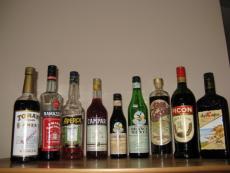
An amaro refers to any liqueur that has a strong bitter component. Amari differ from [ingredient=bitters cocktail bitters] in that they are potable — intended to be consumed in a significant quantity, rather than just a dash or two. Most amari are Italian, and can generally be broken down into two main categories:
Aperitif
- meant to be drunk before meals to stimulate the appetite.
- examples: [ingredient=Campari Campari], [ingredient=Aperol Aperol], [ingredient=gran-classico Gran Classico] and [ingredient=amer-picon Amer Picon]
Digestive
- meant to be drink after meals to aid in digestion
- examples: [ingredient=fernet-branca Fernet Branca], [ingredient=branca-menta Branca Menta], [ingredient=Ramazzotti Ramazzotti], and [ingredient=del-capo Del Capo].
These categories are somewhat fluid, but generally speaking, the darker the amari, the more it's meant as a digestif.
Most amari are blends of herbs and spices in a spirit base. This differentiates them from vermouth, which are wine based. Usually, the herb and spice blends are kept secret, and have anywhere between half a dozen to a hundred different botanicals. Typical bittering agents include wormwood (the basis for [ingredient=absinthe absinthe]), gentian root, cinchona bark (the source of quinine), angostura bark, and quassia. Flavoring agents can include artichoke, bitter citrus, rhubarb, saffron, mace, kola nut, cubeb, mint, menthol and licorice.
Aperitif amari make fantastic summertime cocktails, and can be drunk over ice with a splash of soda. A spritz can be made with the addition of white wine. Digestifs are usually drunk very cold and without the addition of other mixers.
Amari labeled Fernet are typically strongly bitter — even more so than other amari. Many companies make a Fernet, including Branca, Stock, and [ingredient=luxardo Luxardo].
Some popular cocktails containing Amaro
- Douglas Fir Rhubarb Negroni — Gin, Campari, Amaro
- Oona O'Neill — Whiskey, Amaro, Oloroso sherry, Orange bitters, Lemon
- Van Buren — Citrus vodka, Amaro, Sweet vermouth, Chocolate bitters, Lemon peel
- Melody — Sweet vermouth, Amaro, Jägermeister, Peychaud's Bitters, Pussanga
- European tryad — Whiskey, Strega, Suze, Amaro, Orange cream citrate
- The Sherried Cherry — Speyside Scotch, Cherry Liqueur, Averna, Amaro
- Vecchio Tommaso — Amaro, Old Tom Gin, Bianco Vermouth
- Haiti Cocktail (Elvezio Grassi) — Amaro, Demerara Rum, Dry vermouth, Sweet vermouth, Campari, Bitters, Lemon
- Capsized in Calabria — Amaro, Gin, Cap Corse Blanc, Aromatized wine, Bitters, Lemon peel
- Jumpin' Jive — Gin, Framboise, Cherry Liqueur, Amaro, Bitters